Submitted:
09 October 2024
Posted:
11 October 2024
You are already at the latest version
Abstract
Keywords:
1. Introduction
2. The LMT Observation Site and O3-Meteo Datasets
2.1. The Lamezia Terme (LMT) WMO/GAW Station

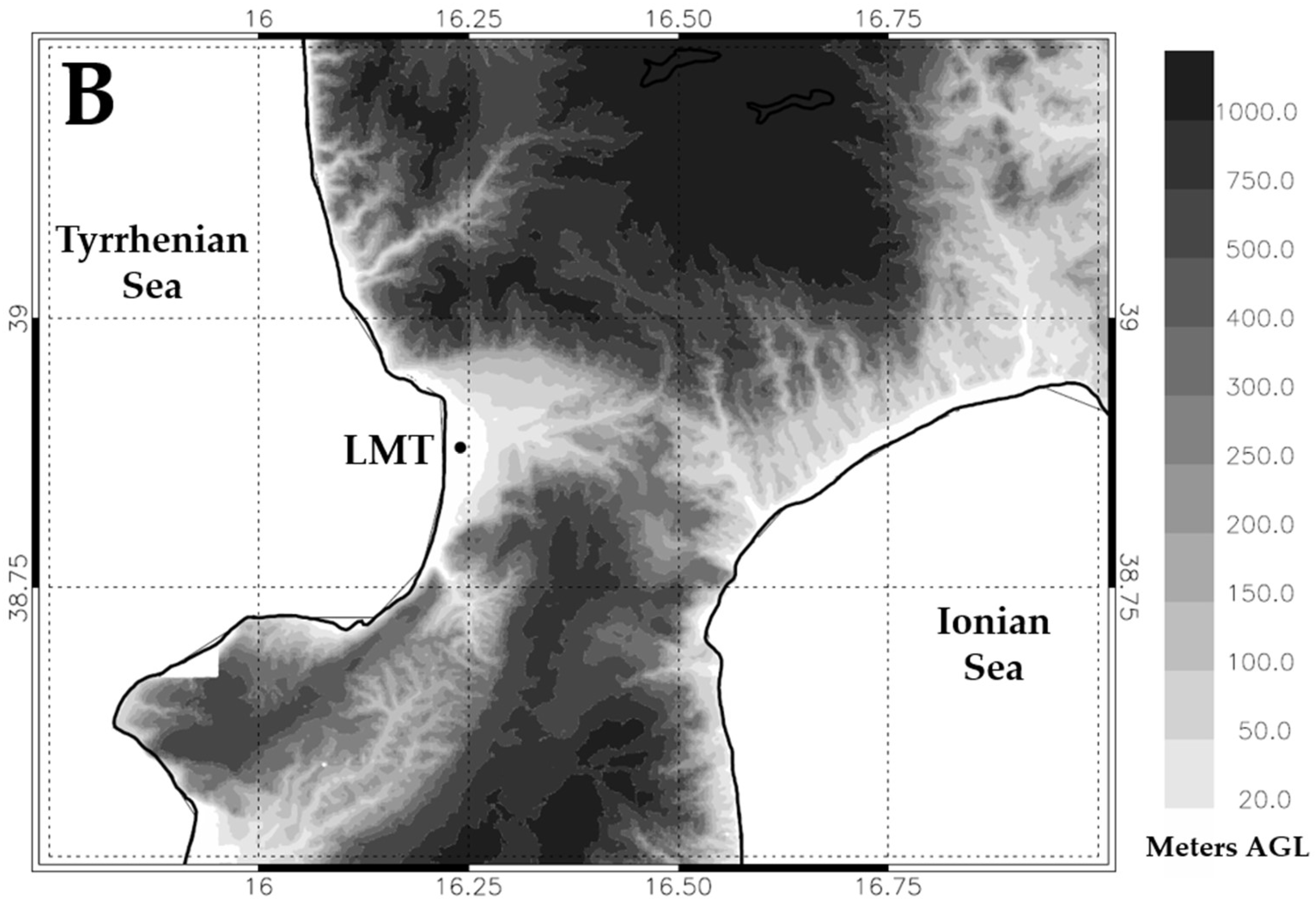
2.2. Instruments and Datasets
3. Results
3.1. Observed Daily Cycles
3.2. Influence of Wind Direction and Speed
3.3. Assessment of OWE (Ozone Weekend Effect)
3.4. Multi-Year Variability
4. Discussion
5. Conclusions
Supplementary Materials
Author Contributions
Funding
Data Availability Statement
Acknowledgments
Conflicts of Interest
References
- Staehelin, J.; Thudium, J.; Buheler, R.; Volz-Thomas, A.; Graber, W. Trends in surface ozone concentrations at Arosa (Switzerland). Atmos. Environ. 1994, 28, 75–78. [CrossRef]
- Smyshlyaev, S.P.; Galin, V.Y.; Blakitnaya, P.A.; Jakovlev, A.R. Numerical Modeling of the Natural and Manmade Factors Influencing Past and Current Changes in Polar, Mid-Latitude and Tropical Ozone. Atmosphere 2020, 11(1), 76. [CrossRef]
- Crutzen, P.J. Photochemical reactions initiated by and influencing ozone in unpolluted tropospheric air. Tellus 1974, 26(1-2), 47-57. [CrossRef]
- Fishman, J.; Solomon, S.; Crutzen, P.J. Observational and theoretical evidence in support of a significant in-situ photochemical source of tropospheric ozone. Tellus 1979, 31(5), 432-446. [CrossRef]
- Logan, J.A. Tropospheric ozone: Seasonal behavior, trends, and anthropogenic influence, J. Geophys. Res.-Atmos. 1985, 90(D6), 10463–10482. [CrossRef]
- Lelieveld, J.; Dentener, F.J. What controls tropospheric ozone? J. Geophys. Res.-Atmos. 2000, 105, 3531–3551. [CrossRef]
- Monks, P.S. Gas-phase radical chemistry in the troposphere. Chem. Soc. Rev. 2005, 34(5), 376-395. [CrossRef]
- Pillar-Little, E.A.; Guzman, M.I. An Overview of Dynamic Heterogeneous Oxidations in the Troposphere. Environments 2018, 5(9), 104. [CrossRef]
- Yenger, J.J.; Klonecky, A.A.; Levy, H. II; Moxim, W.J.; Carmichael, G.R. An evaluation of chemistry's role in the winter-spring ozone maximum found in the northern midlatitude free troposphere. J. Geophys. Res. 1999, 104(D3), 3655–3667. [CrossRef]
- Sahu, L.K. Volatile organic compounds and their measurements in the troposphere. Curr. Sci. 2012, 102, 1645–1649. http://www.jstor.org/stable/24084821 (accessed 31 Aug. 2024).
- Atkinson, R. Atmospheric chemistry of VOCs and NOx. Atmos. Environ. 2000, 34(12-14), 2063–2101. [CrossRef]
- Edwards, D.P.; Emmons, L.K.; Hauglustaine, D.A.; Chu, D.A.; Gille, J.C.; Kaufman, Y.J.; Pétron, G.; Yurganov, L.N.; Giglio, L.; Deeter, M.N.; Yudin, V.; Ziskin, D.C.; Warner, J.; Lamarque, J.-F.; Francis, G.L.; Ho, S.P.; Mao, D.; Chen, J.; Grechko, E.I.; Drummond, J.R. Observations of carbon monoxide and aerosols from the Terra satellite: Northern Hemisphere variability. J. Geophys. Res. Atmospheres 2004, 109(D24). [CrossRef]
- Zheng, B.; Chevallier, F.; Ciais, P.; Yin, Y.; Deeter, M.N.; Worden, H.M.; Wang, Y.; Zhang, Q.; He, K. Rapid decline in carbon monoxide emissions and export from East Asia between years 2005 and 2016. Environ. Res. Lett. 2018, 13(4), 044007. [CrossRef]
- Marenco, A. Variations of CO and O3 in the troposphere: Evidence of O3 photochemistry. Atmos. Environ. 1986, 20(5), 911-918. [CrossRef]
- Solomon, S. Stratospheric ozone depletion: A review of concepts and history. Rev. Geophys. 1999, 37(3), 275–316. [CrossRef]
- Andersen, S.B.; Weatherhead, E.C.; Stevermer, A.; Austin, J.; Brühl, C.; Fleming, E.L.; De Grandpré, J.; Grewe, V.; Isaksen, I.; Pitari, G.; Portmann, R.W.; Rognerud, B.; Rosenfield, J.E.; Smyshlyaev, S.; Nagashima, T.; Velders, G.J.M.; Weisenstein, D.K.; Xia, J. Comparison of recent modeled and observed trends in total column ozone. J. Geophys. Res.-Atmos. 2006, 111(D2), 4428. [CrossRef]
- Egorova, T.; Rozanov, E.; Arsenovic, P.; Sukhodolov, T. Ozone Layer Evolution in the Early 20th Century. Atmosphere 2020, 11(2), 169. [CrossRef]
- De Marco, A. Assessment of present and future risk to Italian forests and human health: Modelling and mapping. Environ. Pollut. 2009, 157(5), 1407-1412. [CrossRef]
- Palli, D.; Sera, F.; Giovannelli, L.; Masala, G.; Grechi, D.; Bendinelli, B.; Caini, S.; Dolara, P. Environmental ozone exposure and oxidative DNA damage in adult residents in Florence, Italy. Environ. Pollut. 2009, 157(5), 1521-1525. [CrossRef]
- Nuvolone, D.; Petri, D.; Voller, F. The effects of ozone on human health. Environ. Sci. Pollut. Res. Int. 2018, 25, 8074–8088. [CrossRef]
- Malashock, D.A.; DeLang, M.N.; Becker, J.S.; Serre, M.L.; West, J.J.; Chang, K.-L.; Cooper, O.R.; Anenberg, S.C. Estimates of ozone concentrations and attributable mortality in urban, peri-urban and rural areas worldwide in 2019. Environ. Res. Lett. 2022, 17, 054023. [CrossRef]
- Olstrup, H.; Åström, C.; Orru, H. Daily Mortality in Different Age Groups Associated with Exposure to Particles, Nitrogen Dioxide and Ozone in Two Northern European Capitals: Stockholm and Tallinn. Environments 2022, 9(7), 83. [CrossRef]
- Donzelli, G.; Suarez-Varela, M.M. Tropospheric Ozone: A Critical Review of the Literature on Emissions, Exposure, and Health Effects. Atmosphere 2024, 15(7), 779. [CrossRef]
- Fuhrer, J.; Skärby, L.; Ashmore, M.R. Critical levels for ozone effects on vegetation in Europe. Environ. Pollut. 1997, 97(1-2), 91-106. [CrossRef]
- Matyssek, R.; Innes, J. Ozone - a Risk Factor for Trees and Forests in Europe? Water Air Soil Pollut. 1999, 116, 199–226. [CrossRef]
- Krupa, S.; McGrath, M.T.; Andersen, C.P.; Booker, F.L.; Burkey, K.O.; Chappelka, A.H.; Chevone, B.I.; Pell, E.J.; Zilinskas, B.A. Ambient Ozone and Plant Health. Plant Dis. 2001, 85(1), 4-12. [CrossRef]
- Paoletti, E. Ozone impacts on forests. CAB Reviews 2007, 2(68), 13 . [CrossRef]
- Fagnano, M.; Maggio, A.; Fumagalli, I. Crops’ responses to ozone in Mediterranean environments. Environ. Pollut. 2009, 157(5), 1438-1444. [CrossRef]
- Carrari, E.; De Marco, A.; Laschi, A.; Badea, O.; Dalstein-Richier, L.; Fares, S.; Leca, S.; Marchi, E.; Sicard, P.; Popa, I.; Hoshika, Y.; Materassi, A.; Pallante, G.; Pitar, D.; Paoletti, E. Economic and Life Cycle Analysis of Passive and Active Monitoring of Ozone for Forest Protection. Environments 2021, 8(10), 104. [CrossRef]
- Conte, A.; Otu-Larbi, F.; Alivernini, A.; Hoshika, Y.; Paoletti, E.; Ashworth, K.; Fares, S. Exploring new strategies for ozone-risk assessment: A dynamic-threshold case study. Environ. Pollut. 2021, 287, 117620. [CrossRef]
- International Global Atmospheric Chemistry. Tropospheric Ozone Assessment Report (TOAR): Global metrics for climate change, human health and crop/ecosystem research. https://igacproject.org/activities/TOAR (accessed on 12 September 2024).
- Fares, S.; Vargas, R.; Detto, M.; Goldstein, A.H.; Karlik, J.; Paoletti, E.; Vitale, M. Tropospheric ozone reduces carbon assimilation in trees: estimates from analysis of continuous flux measurements. Glob. Change Biol. 2013, 19(8), 2427-2443. [CrossRef]
- Kiehl, J.T.; Schneider, T.L.; Portmann, R.W.; Solomon, S. Climate forcing due to tropospheric and stratospheric ozone. J. Geophys. Res. 1999, 104(D24), 31239-31254. [CrossRef]
- Berntsen, T.K.; Myhre, G.; Stordal, F.; Isaksen, I.S.A. Time evolution of tropospheric ozone and its radiative forcing. J. Geophys. Res. 2000, 105(D7), 8915-8930. [CrossRef]
- Myhre, G.; Karlsdóttir, S.; Isaksen, I.S.A.; Stordal, F. Radiative forcing due to changes in tropospheric ozone in the period 1980 to 1996. J. Geophys. Res. 2000, 105(D23), 28935-28942. [CrossRef]
- Hauglustaine, D.A.; Brasseur, G.P. Evolution of tropospheric ozone under anthropogenic activities and associated radiative forcing of climate. J. Geophys. Res. 2001, 106(D23), 32337-32360. [CrossRef]
- Moore, F.C. Climate Change and Air Pollution: Exploring the Synergies and Potential for Mitigation in Industrializing Countries. Sustainability 2009, 1(1), 43-54. [CrossRef]
- Screpanti, A.; De Marco, A. Corrosion of cultural heritage buildings in Italy: A role for ozone? Environ. Pollut. 2009, 157(5), 1513-1520. [CrossRef]
- Wang, X.; Li, H.; Wang, Y.; Zhao, X. Quantifying the Potential Co-Benefit of Air Quality Improvement on Cultural Heritage in China. Sustainability 2023, 15(11), 8709. [CrossRef]
- Massey, S.W. The effects of ozone and NOx on the deterioration of calcareous stone. Sci. Total Environ. 1999, 227(2-3), 109–121. [CrossRef]
- Coyle, M.; Smith, R.I.; Stedman, J.R.; Weston, K.J.; Fowler, D. Quantifying the spatial distribution of surface ozone concentration in the UK. Atmos. Environ. 2002, 36(6), 1013-1024. [CrossRef]
- Ivaskova, M.; Kotes, P.; Brodnan, M. Air Pollution as an Important Factor in Construction Materials Deterioration in Slovak Republic. Procedia Eng. 2015, 108, 131–138. [CrossRef]
- Holton, J.R.; Haynes, P.H.; McIntyre, M.E.; Douglass, A.R.; Rood, R.B.; Pfister, L. Stratosphere-troposphere exchange. Rev. Geophys. 1995, 33(4), 403-439. [CrossRef]
- Roelofs, G.-J.; Lelieveld, J. Model study of the influence of cross-tropopause O3 transports on tropospheric O3 levels. Tellus Ser. B 1997, 49(1), 38–55. [CrossRef]
- Stohl, A.; Bonasoni, P.; Cristofanelli, P.; Collins, W.; Feichter, J.; Frank, A.; Forster, C.; Gerasopoulos, E.; Gäggeler, H.; James, P.; Kentarchos, T.; Kromp-Kolb, H.; Krüger, B.; Land, C.; Meloen, J.; Papayannis, A.; Priller, A.; Seibert, P.; Sprenger, M.; Roelofs, G.J.; Scheel, H.E.; Schnabel, C.; Siegmund, P.; Tobler, L.; Trickl, T.; Wernli, H.; Wirth, V.; Zanis, P.; Zerefos, C. Stratosphere-troposphere exchange: A review, and what we have learned from STACCATO. J. Geophys. Res.-Atmos. 2003, 108(D12). [CrossRef]
- Cristofanelli, P.; Bonasoni, P.; Tositti, L.; Bonafè, U.; Calzolari, F.; Evangelisti, F.; Sandrini, S.; Stohl, A. A 6-year analysis of stratospheric intrusions and their influence on ozone at Mt. Cimone (2165 m above sea level). J. Geophys. Res.-Atmos. 2006, 111(D3). [CrossRef]
- Knowland, K.E.; Ott, L.E.; Duncan, B.N.; Wargan, K. Stratospheric Intrusion-Influenced Ozone Air Quality Exceedances Investigated in the NASA MERRA-2 Reanalysis. Geophys. Res. Lett. 2017, 44(20), 10691-10701. [CrossRef]
- Young, P.J.; Naik, V.; Fiore, A.M.; Gaudel, A.; Guo, J.; Lin, M.Y.; Neu, J.L.; Parrish, D.D.; Rieder, H.E.; Schnell, J.L.; Tilmes, S.; Wild, O.; Zhang, L.; Ziemke, J.; Brandt, J.; Delcloo, A.; Doherty, R.M.; Geels, C.; Hegglin, M.I.; Hu, L.; Im, U.; Kumar, R.; Luhar, A.; Murray, L.; Plummer, D.; Rodriguez, J.; Saiz-Lopez, A.; Schultz, M.G.; Woodhouse, M.T.; Zeng, G. Tropospheric Ozone Assessment Report: Assessment of global-scale model performance for global and regional ozone distributions, variability, and trends. Elem. Sci. Anth. 2018, 6, 10. [CrossRef]
- Akritidis, D.; Katragkou, E.; Zanis, P.; Pytharoulis, I.; Melas, D.; Flemming, J.; Inness, A.; Clark, H.; Plu, M.; Eskes, H. A deep stratosphere-to-troposphere ozone transport event over Europe simulated in CAMS global and regional forecast systems: analysis and evaluation. Atmos. Chem. Phys. 2018, 18(20), 15515–15534. [CrossRef]
- Akritidis, D.; Pozzer, A.; Zanis, P. On the impact of future climate change on tropopause folds and tropospheric ozone. Atmos. Chem. Phys. 2019, 19(22), 14387-14401. [CrossRef]
- Abalos, M.; Orbe, C.; Kinnison, D.E.; Plummer, D.; Oman, L.D.; Jöckel, P.; Morgenstern, O.; Garcia, R.R.; Zeng, G.; Stone, K.A.; Dameris, M. Future trends in stratosphere-to-troposphere transport in CCMI models. Atmos. Chem. Phys. 2020, 20(11), 6883-6901. [CrossRef]
- Trisolino, P.; Putero, D.; Arduini, J.; Amendola, S.; Calzolari, F.; Cristofanelli, P. Influence of deep stratosphere-to-troposphere transport on atmospheric carbon dioxide and methane at the Mt. Cimone WMO/GAW global station (2165 m a.s.l., Italy): A multi-year (2015–2022) investigation. Atmos. Res. 2024, 310, 107627. https://www.sciencedirect.com/science/article/pii/S0169809524004095.
- von Schneidemesser, E.; Monks, P.S.; Allan, J.D.; Bruhwiller, L.; Forster, P.; Fowler, D.; Lauer, A.; Morgan, W.T.; Paasonen, P.; Righi, M.; Sindelarova, K.; Sutton, M.A. Chemistry and Linkages between Air Qualirt and Climate Change. Chem. Rev. 2015, 115(10), 3856-3897. [CrossRef]
- Szopa, S.; Naik, V.; Adhikary, B.; Artaxo, P.; Berntsen, T.; Collins, W.D.; Fuzzi, S.; Gallardo, L.; Kiendler-Scharr, A.; Klimont, Z.; Liao, H.; Unger, N.; Zanis, P. Short-Lived Climate Forcers. In: Climate Change 2021: The Physical Science Basis. Contribution of Working Group I to the Sixth Assessment Report of the Intergovernmental Panel on Climate Change, edited by: Masson-Delmotte, V., Zhai, P., Pirani, A., Connors, S.L., Péan, C., Berger, S., Caud, N., Chen,Y., Goldfarb, L., Gomis, M.I., Huang, M., Leitzell, K., Lonnoy, E., Matthews, J.B.R., Maycock, T.K., Waterfield, T., Yelekçi, O., Yu, R., and Zhou, B. Cambridge University Press, Cambridge, United Kingdom and New York, NY, USA, 2021, pgs. 817–922.
- Butchart, N.; Scaife, A. Removal of chlorofluorocarbons by increased mass exchange between the stratosphere and troposphere in a changing climate. Nature 2001, 410, 799–802. [CrossRef]
- Collins, W.J.; Derwent, R.G.; Garnier, B.; Johonson, C.E.; Sanderson, M.G.; Stevenson, D.S. Effect of stratosphere-troposphere exchange on the future tropospheric ozone trend. J. Geophys. Res. 2003, 108(D12), 8528. [CrossRef]
- Land, C.; Feichter, J. Stratosphere-troposphere exchange in a changing climate simulated with the general circulation model MAECHAM4. J. Geophys. Res. 2003, 108(D12), 8523. [CrossRef]
- Sudo, K.; Masaaki, Y.; Akimoto, H. Future changes in stratosphere-troposphere exchange and their impacts on future tropospheric ozone simulations, Geophys. Res. Lett. 2003, 30(24), 2256. [CrossRef]
- Trickl, T.; Bärtsch-Ritter, N.; Eisele, H.; Furger, M.; Mücke, R.; Sprenger, M.; Stohl, A. High-ozone layers in the middle and upper troposphere above Central Europe: potential import from the stratosphere along the subtropical jet stream. Atmos. Chem. Phys. 2011, 11(17), 9343-9366. [CrossRef]
- Bonasoni, P.; Evangelisti, F.; Bonafe, U.; Ravegnani, F.; Calzolari, F.; Stohl, A.; Tositti, L.; Tubertini, O.; Colombo, T. Stratospheric ozone intrusion episodes recorded at Mt. Cimone during the VOTALP project: case studies. Atmos. Environ. 2000, 34(9), 1355-1365. [CrossRef]
- Colombo, T.; Santaguida, R.; Capasso, A.; Calzolari, F.; Evangelisti, F.; Bonasoni, P. Biospheric influence on carbon dioxide measurements in Italy. Atmos. Environ. 2000, 34(29-30), 4963-4969. [CrossRef]
- Langford, A.O.; Senff, C.J.; Alvarez, R.J. II; Aikin, K.C.; Baidar, S.; Bonin, T.A.; W. Brewer, W.A.; Brioude, J.; Brown, S.S.; Burley, J.D.; Caputi, D.J.; Conley, S.A.; Cullis, P.D.; Decker, Z.C.J.; Evan, S.; Kirgis, G.; Lin, M.; Pagowski, M.; Peischl, J.; Petropavlovskikh, I.; Pierce, R.B.; Ryerson, T.B.; Sandberg, S.P.; Sterling, C.W.; Weickmann, A.M.; Zhang, L. The Fires, Asian, and Stratospheric Transport–Las Vegas Ozone Study (FAST-LVOS). Atmos. Chem. Phys. 2022, 22(3), 1707-1737. [CrossRef]
- Cristofanelli, P.; Bonasoni, P. Background ozone in the southern Europe and Mediterranean area: Influence of the transport processes. Environ. Pollut. 2009, 157(5), 1399-1406. [CrossRef]
- Chevalier, A.; Gheusi, F.; Delmas, R.; Ordóñez, C.; Sarrat, C.; Zbinden, R.; Thouret, V.; Athier, G.; Cousin, J.-M. Influence of altitude on ozone levels and variability in the lower troposphere: a ground-based study for western Europe over the period 2001–2004. Atmos. Chem. Phys. 2007, 7(16), 4311-4326. [CrossRef]
- Zvyagintsev, A.M.; Kakadzhanova, G.; Kruchenitskii, G.M.; Tarasova, O.A. Periodic variability of surface ozone concentration over western and central Europe from observational data. Russ. Meteorol. Hydrol. 2008, 33, 159–166. [CrossRef]
- Nolle, M.; Ellul, R.; Heinrich, G.; Güsten, H. A long-term study of background ozone concentrations in the Central Mediterranean-Diurnal and seasonal variations on the island of Gozo. Atmos. Environ. 2002, 36(8), 1391–1402. [CrossRef]
- Gerasopoulos, E.; Kouvarakis, G.; Vrekoussis, M.; Donoussis, C.; Mihalopoulos, N.; Kanakidou, M. Photochemical ozone production in the Eastern Mediterranean. Atmos. Environ. 2006, 40(17), 3057–3069. [CrossRef]
- Kalabokas, P.D.; Mihalopoulos, N.; Ellul, R.; Kleanthous, S.; Repapis, C.C. An investigation of the meteorological and photochemical factors influencing the background rural and marine surface ozone levels in the Central and Eastern Mediterranean. Atmos. Environ. 2008, 42(34), 7894–7906. [CrossRef]
- Cristofanelli, P.; Fierli, F.; Graziosi, F.; Steinbacher, M.; Couret, C.; Calzolari, F.; Roccato, F.; Landi, T.; Putero, D.; Bonasoni, P. Decadal O3 variability at the Mt. Cimone WMO/GAW global station (2,165 m a.s.l., Italy) and comparison with two high-mountain “reference” sites in Europe. Elem. Sci. Anth. 2020, 8(1), 42. [CrossRef]
- Matasović, B.; Saliba, M.; Muscat, R.; Grima, M.; Ellul, R. Long-Term Tropospheric Ozone Data Analysis 1997–2019 at Giordan Lighthouse, Gozo, Malta. Atmosphere 2023, 14(9), 1446. [CrossRef]
- Di Carlo, P.; Pitari, G.; Mancini, E.; Gentile, S.; Pichelli, E.; Visconti, G. Evolution of surface ozone in central Italy based on observations and statistical model. J. Geophys. Res.-Atmos. 2007, 112(D10). [CrossRef]
- Cristofanelli, P.; Di Carlo, P.; Aruffo, E.; Apadula, F.; Bencardino, M.; D’Amore, F.; Bonasoni, P.; Putero, D. An Assessment of Stratospheric Intrusions in Italian Mountain Regions Using STEFLUX. Atmosphere 2018, 9(10), 413. [CrossRef]
- Guaita, P.R.; Marzuoli, R.; Gerosa, G.A. A regional scale flux-based O3 risk assessment for winter wheat in northern Italy, and effects of different spatio-temporal resolutions. Environ. Pollut. 2023, 333, 121860. [CrossRef]
- Volz, A.; Kley, D. Evaluation of the Montsouris series of ozone measurements made in the nineteenth century. Nature 1988, 332, 240-242. [CrossRef]
- Anfossi, D.; Sandroni, S.; Viarengo, S. Tropospheric ozone in the nineteenth century: the Moncalieri series. J. Geophys. Res.-Atmos. 1991, 96(D9), 17349-17352. [CrossRef]
- Paoletti, E.; De Marco, A.; Racalbuto, S. Why Should We Calculate Complex Indices of Ozone Exposure? Results from Mediterranean Background Sites. Environ. Monit. Assess. 2007, 128, 19–30. [CrossRef]
- Mills, G.; Pleijel, H.; Malley, C.S.; Sinha, B.; Cooper, O.R.; Schultz, M.G.; Neufeld, H.S.; Simpson, D.; Sharps, K.; Feng, Z.; Gerosa, G.; Harmens, H.; Kobayashi, K.; Saxena, P.; Paoletti, E.; Sinha, V.; Xu, X. Tropospheric Ozone Assessment Report: Present-day tropospheric ozone distribution and trends relevant to vegetation. Elem Sci Anth. 2018, 6(1), 47. [CrossRef]
- Nali, C.; Pucciarello, C.; Lorenzini, G. Mapping Ozone Critical Levels for Vegetation in Central Italy. Water Air Soil Pollut. 2002, 141, 337-347. [CrossRef]
- Nali, C.; Crocicchi, L.; Lorenzini, G. Plants as indicators of urban air pollution (ozone and trace elements) in Pisa, Italy. J. Environ. Monit. 2004, 6, 636-645. [CrossRef]
- Paoletti, E. Impact of ozone on Mediterranean forests: A review. Environ. Pollut. 2006, 144(2), 463-474. [CrossRef]
- Nali, C.; Balducci, E.; Frati, L.; Paoli, L.; Loppi, S.; Lorenzini, G. Integrated biomonitoring of air quality with plants and lichens: A case study on ambient ozone from central Italy. Chemosphere 2007, 67(11), 2169-2176. [CrossRef]
- Cleveland, W.S.; Graedel, T.E.; Kleiner, B.; Warner, J.L. Sunday and Workday Variations in Photochemical Air Pollutants in New Jersey and New York. Science 1974, 186, 1037-1038. [CrossRef]
- Hernández-Paniagua, I.Y.; Lopez-Farias, R.; Piña-Mondragón, J.J.; Pichardo-Corpus, J.A.; Delgadillo-Ruiz, O.; Flores-Torres, A.; García-Reynoso, A.; Ruiz-Suárez, L.G.; Mendoza, A. Increasing Weekend Effect in Ground-Level O3 in Metropolitan Areas of Mexico during 1988–2016. Sustainability 2018, 10, 3330. [CrossRef]
- Sicard, P.; Paoletti, E.; Agathokleous, E.; Araminienė, V.; Proietti, C.; Coulibaly, F.; De Marco, A. Ozone weekend effect in cities: Deep insights for urban air pollution control. Environ. Res. 2020, 191, 110193. [CrossRef]
- Lebron, F. A comparison of weekend–weekday ozone and hydrocarbon concentrations in the Baltimore-Washington metropolitan area. Atmos. Environ. 1975, 9(9), 861-863. [CrossRef]
- Elkus, B.; Wilson, K.R. Photochemical air pollution: Weekend-weekday differences. Atmos. Environ. 1977, 11(6), 509-515. [CrossRef]
- D’Amico, F.; Ammoscato, I.; Gullì, D.; Lo Feudo, T.; De Pino, M.; Cristofanelli, P.; Malacaria, L.; Parise, D.; Sinopoli, S.; De Benedetto, G.; Calidonna, C.R. Integrated analysis of methane cycles and trends at the WMO/GAW station of Lamezia Terme (Calabria, Southern Italy). Atmosphere 2024, 15(8), 946. [CrossRef]
- D’Amico, F.; Ammoscato, I.; Gullì, D.; Lo Feudo, T.; De Pino, M.; Cristofanelli, P.; Malacaria, L.; Parise, D.; Sinopoli, S.; De Benedetto, G.; Calidonna, C.R. Anthropic-induced variability of greenhouse gases and aerosols at the WMO/GAW coastal site of Lamezia Terme (Calabria, Southern Italy): towards a new method to assess the weekly distribution of gathered data. Sustainability 2024, 16(18), 8175. [CrossRef]
- D’Amico, F.; Ammoscato, I.; Gullì, D.; Lo Feudo, T.; De Pino, M.; Cristofanelli, P.; Malacaria, L.; Parise, D.; Sinopoli, S.; De Benedetto, G.; Calidonna, C.R. Trends in CO, CO2, CH4, BC, and NOx during the first 2020 COVID-19 lockdown: source insights from the WMO/GAW station of Lamezia Terme (Calabria, Southern Italy). Sustainability 2024, 16(18), 8229. [CrossRef]
- Donateo, A.; Lo Feudo, T.; Marinoni, A.; Calidonna, C.R.; Contini, D.; Bonasoni, P. Long-term observations of aerosol optical properties at three GAW regional sites in the Central Mediterranean. Atmos. Res. 2020, 241, 104976. [CrossRef]
- Shen, Y.; Liu, J.; Chen, Z.; Yang, M.; Shu, L.; Gai, C.; Jiang, Y. Influence of Wind Flows on Surface O3 Variation over a Coastal Province in Southeast China. Atmosphere 2024, 15(3), 262. [CrossRef]
- Cristofanelli, P.; Busetto, M.; Calzolari, F.; Ammoscato, I.; Gullì, D.; Dinoi, A.; Calidonna, C.R.; Contini, D.; Sferlazzo, D.; Di Iorio, T.; Piacentino, S.; Marinoni, A.; Maione, M.; Bonasoni, P. Investigation of reactive gases and methane variability in the coastal boundary layer of the central Mediterranean basin. Elem. Sci. Anth. 2017, 5, 12. [CrossRef]
- Federico, S.; Pasqualoni, L.; De Leo, L.; Bellecci, C. A study of the breeze circulation during summer and fall 2008 in Calabria, Italy. Atmos. Res. 2010, 97(1-2), pgs. 1-13. [CrossRef]
- Federico, S.; Pasqualoni, L.; Sempreviva, A.M.; De Leo, L.; Avolio, E.; Calidonna, C.R.; Bellecci, C. The seasonal characteristics of the breeze circulation at a coastal Mediterranean site in South Italy. Adv. Sci. Res. 2010, 4, pgs. 47–56. [CrossRef]
- Gullì, D.; Avolio, E.; Calidonna, C.R.; Lo Feudo, T.; Torcasio, R.C.; Sempreviva, A.M. Two years of wind-lidar measurements at an Italian Mediterranean Coastal Site. In European Geosciences Union General Assembly 2017, EGU – Division Energy, Resources & Environment, ERE. Energy Procedia 2017, 125, pgs. 214-220. [CrossRef]
- Avolio, E.; Federico, S.; Miglietta, M.M.; Lo Feudo, T.; Calidonna, C.R.; Sempreviva, A.M. Sensitivity analysis of WRF model PBL schemes in simulating boundary-layer variables in southern Italy: An experimental campaign. Atmos. Res. 2017, 192, 58-71. [CrossRef]
- Lo Feudo, T.; Calidonna, C.R.; Avolio, E.; Sempreviva, A.M. Study of the Vertical Structure of the Coastal Boundary Layer Integrating Surface Measurements and Ground-Based Remote Sensing. Sensors 2020, 20, 6516. [CrossRef]
- Malacaria, L.; Parise, D.; Lo Feudo, T.; Avolio, E.; Ammoscato, I.; Gullì, D.; Sinopoli, S.; Cristofanelli, P.; De Pino, M.; D’Amico, F.; Calidonna, C.R. Multiparameter detection of summer open fire emissions: the case study of GAW regional observatory of Lamezia Terme (Southern Italy). Fire 2024, 7(6), 198. [CrossRef]
- Calidonna, C.R.; Avolio, E.; Gullì, D.; Ammoscato, I.; De Pino, M.; Donateo, A.; Lo Feudo, T. Five Years of Dust Episodes at the Southern Italy GAW Regional Coastal Mediterranean Observatory: Multisensors and Modeling Analysis. Atmosphere 2020, 11(5), 456. [CrossRef]
- Carslaw, D.C.; K. Ropkins. openair — an R package for air quality data analysis. Environ. Model. Softw. 2012, 27-28, 52–61. [CrossRef]
- Carslaw, D.C. The openair manual — open-source tools for analysing air pollution data. Manual for version 2.6-6, 2019, University of York.
- Schipa, I.; Tanzarella, A.; Mangia, C. Differences between weekend and weekday ozone levels over rural and urban sites in Southern Italy. Environ. Monit. Assess. 2009, 156, 509–523. [CrossRef]
- Karagodin-Doyennel, A., Rozanov, E., Sukhodolov, T., Egorova, T., Sedlacek, J., and Peter, T.: The future ozone trends in changing climate simulated with SOCOLv4, Atmos. Chem. Phys. 2023, 23(8), 4801–4817. [CrossRef]
- Sicard, P.; De Marco, A.; Agathokleous, E.; Feng, Z.; Xu, X.; Paoletti, E.; Diéguez Rodriguez, J.J.; Calatayud, C. Amplified ozone pollution in cities during the COVID-19 lockdown. Sci. Total Environ. 2020, 735, 139542. [CrossRef]
- Pey, J.; Cerro, J.C. Reasons for the observed tropospheric ozone weakening over south-western Europe during COVID-19: Strict lockdown versus the new normal. Sci. Total Environ. 2022, 833, 155162. [CrossRef]
- Cristofanelli, P.; Arduni, J.; Serva, F.; Calzolari, F.; Bonasoni, P.; Busetto, M.; Maione, M.; Sprenger, M.; Trisolino, P.; Putero, D. Negative ozone anomalies at a high mountain site in northern Italy during 2020: a possible role of COVID-19 lockdowns? Environ. Res. 2021, 16(7), 074029. [CrossRef]
- Putero, D.; Cristofanelli, P.; Chang, K.-L.; Dufour, G.; Beachley, G.; Couret, C.; Effertz, P.; Jaffe, D.A.; Kubistin, D.; Lynch, J.; Petrovalovskikh, I.; Puchalski, M.; Sharac, T.; Sive, B.C.; Steinbacher, M.; Torres, C.; Cooper, O.R. Fingerprints of the COVID-19 economic downturn and recovery on ozone anomalies at high-elevation sites in North American and western Europe. Atmos. Chem. Phys. 2023, 23(24), 15693-15709. [CrossRef]
- Li, Y.S.; Yin, S.S.; Yu, S.J.; Bai, L.; Wang, X.D.; Lu, X.; Ma, S.L. Characteristics of ozone pollution and the sensitivity to precursors during early summer in central plain. China. J. Environ. Sci. 2021, 99, 354–368. [CrossRef]
- Qiu, S.; Du, R.; Tang, G.; Zang, K.; Lin, Y.; Chen, Y.; Qing, X.; Li, J.; Xiong, H.; Jiang, K.; Hong, H.; Fang, S. Characteristics of Surface Ozone and Nitrogen Oxides over a Typical City in the Yangtze River Delta, China. Atmosphere 2023, 14(3), 487. [CrossRef]
- Real, E.; Couvidat, F.; Chantreux, A.; Megaritis, A.; Valastro, G.; Colette, A. Assessing the Robustness of Ozone Chemical Regimes to Chemistry-Transport Model Configurations. Atmosphere 2024, 15(5), 532. [CrossRef]
- Cantatore, E.; Fatiguso, F. An Energy-Resilient Retrofit Methodology to Climate Change for Historic Districts. Application in the Mediterranean Area. Sustainability 2021, 13(3), 1422. [CrossRef]
- Urbina Leonor, L.M.; Sosa Echeverría, R.; Perez, N.A.; Vega, E.; Kahl, J.D.W.; Solano Murillo, M.; Soto Ayala, R. Importance of Atmospheric Sciences in Stone Heritage Conservation Study in Italy and Mexico. Sustainability 2023, 15(6), 5321. [CrossRef]
- Bostenaru Dan, M.; Ibric, A.; Popescu, M.; Crăciun, C. Architectural Heritage and Archetypal Landscape Approaches Facing Environmental Hazards. Sustainability 2024, 16(4), 1505. [CrossRef]
- López Campos, L.I.; Prestileo, F.; Stella, E.M.; Mascitelli, A.; Aruffo, E.; Chiacchiaretta, P.; Di Carlo, P.; Dietrich, S. Heritage Resilience and Identity: Lesson from Trabocchi Coast about Climate Change Adaptation Strategies. Sustainability 2024, 16(14), 5848. [CrossRef]
- Duchi, R.; Cristofanelli, P.; Landi, T.C.; Arduini, J.; Bonafe’, U.; Bourcier, L.; Busetto, M.; Calzolari, F.; Marinoni, A.; Putero, D.; Bonasoni, D. Long-term (2002–2012) investigation of Saharan dust transport events at Mt. Cimone GAW global station, Italy (2165 m a.s.l.). Elem. Sci. Anth. 2016, 4, 85. [CrossRef]
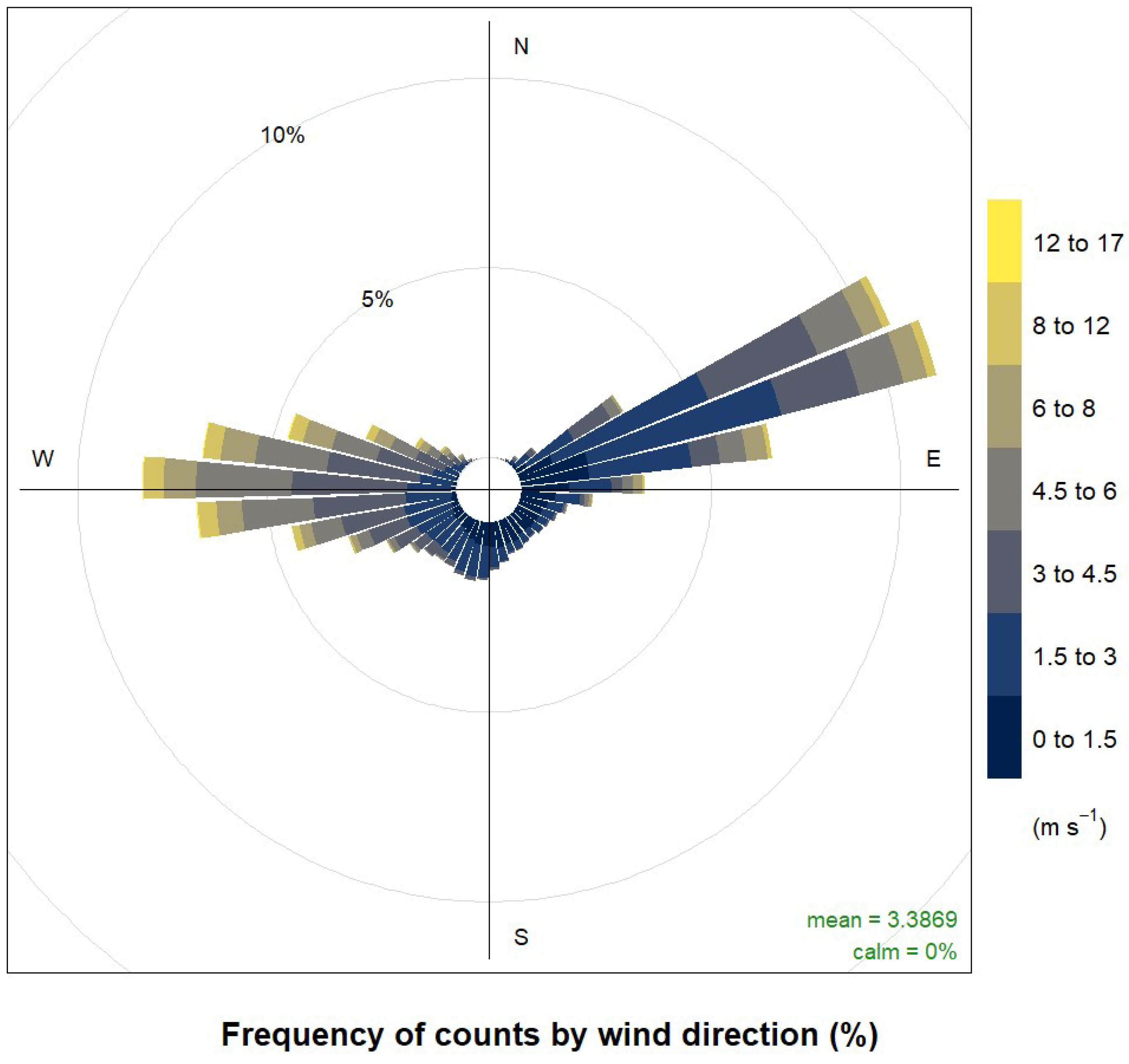


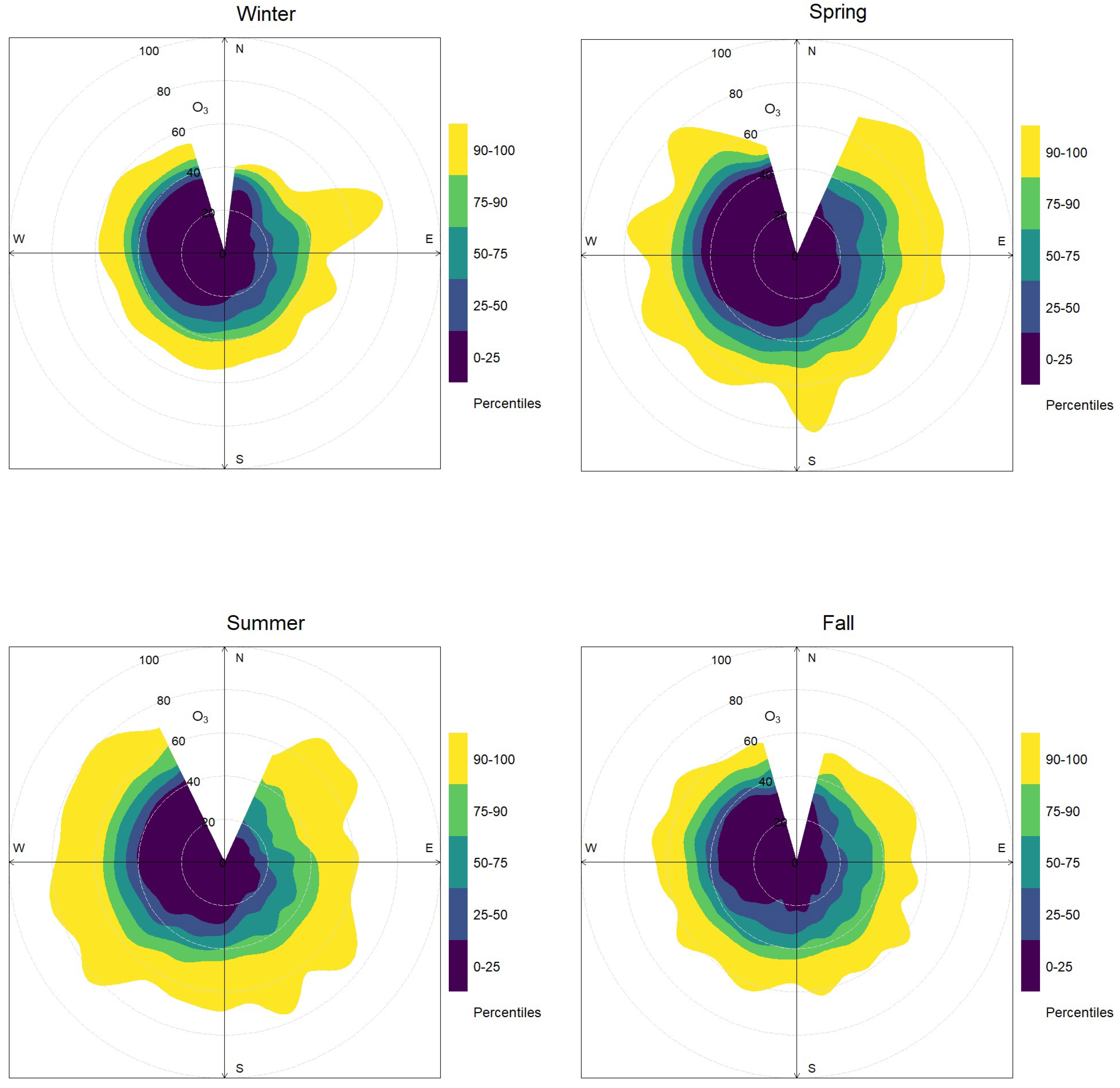
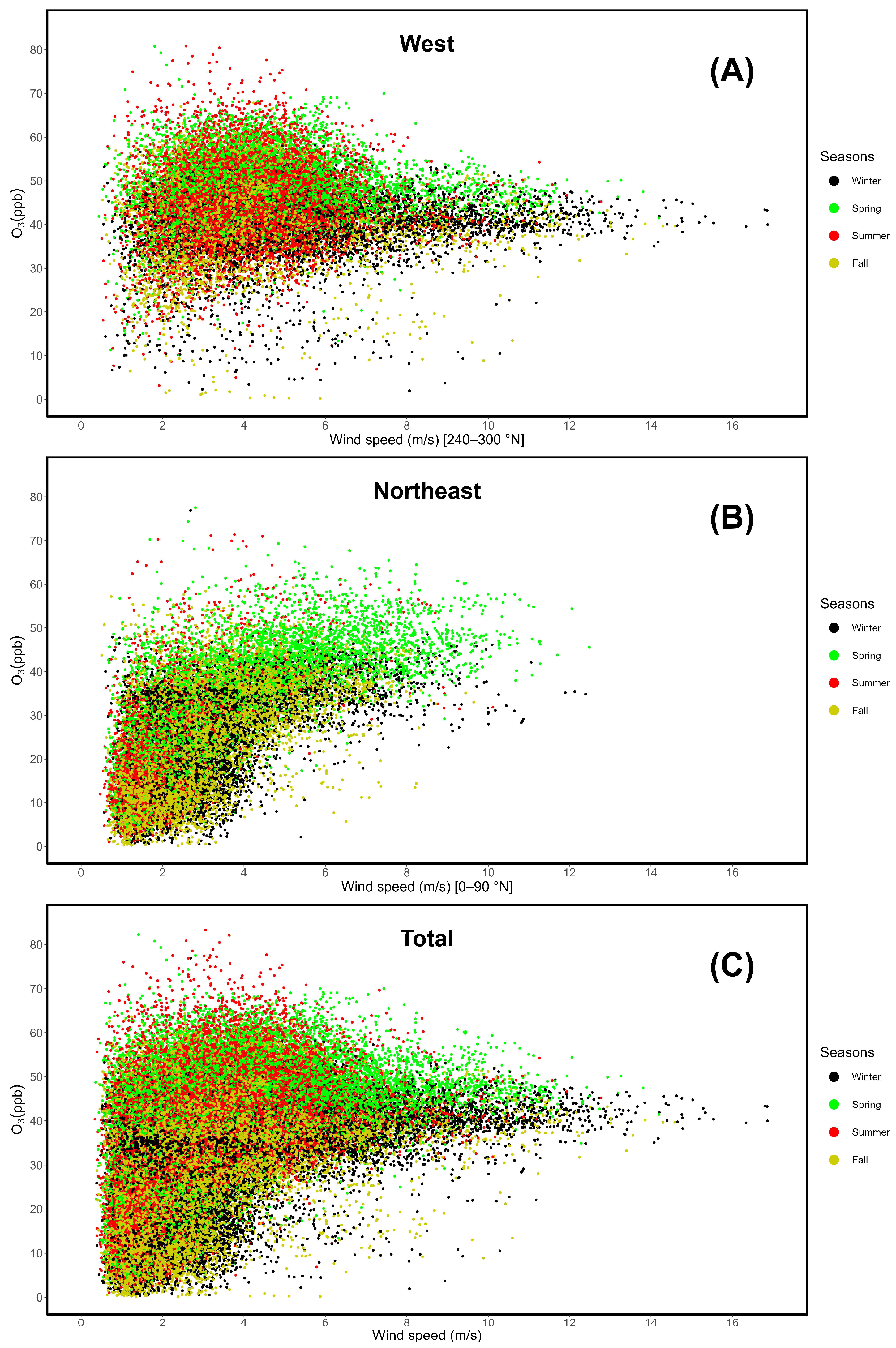
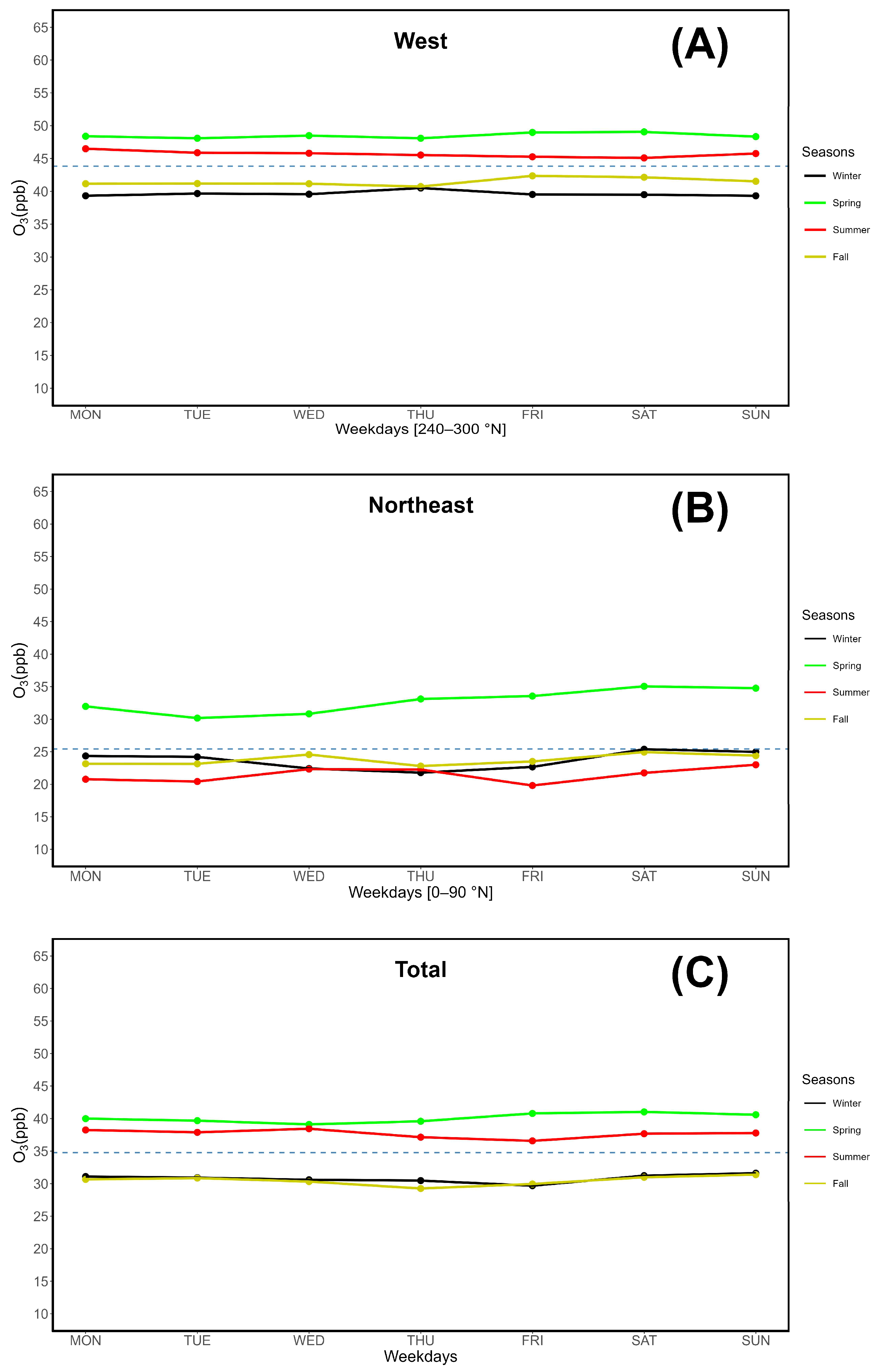
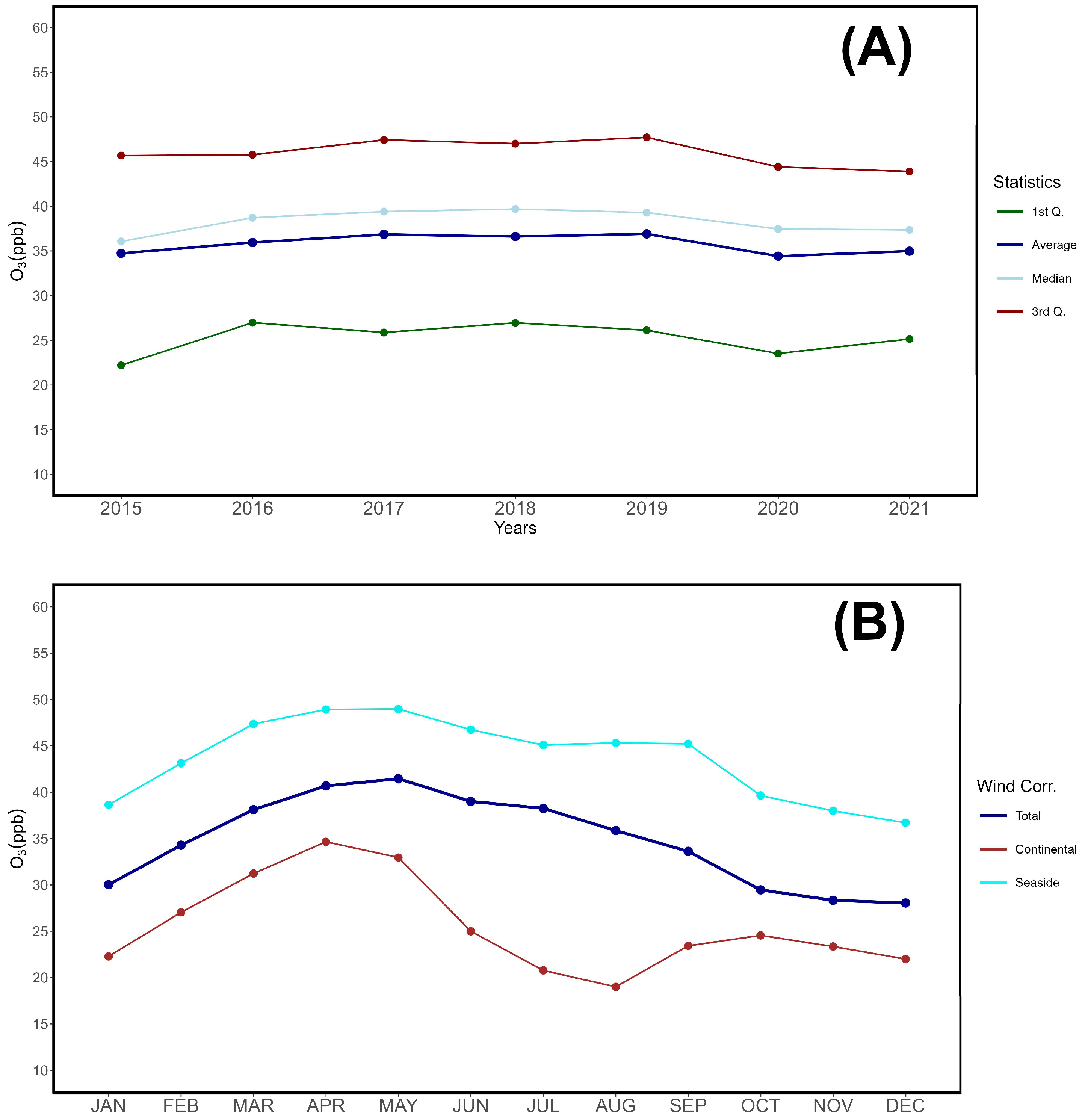
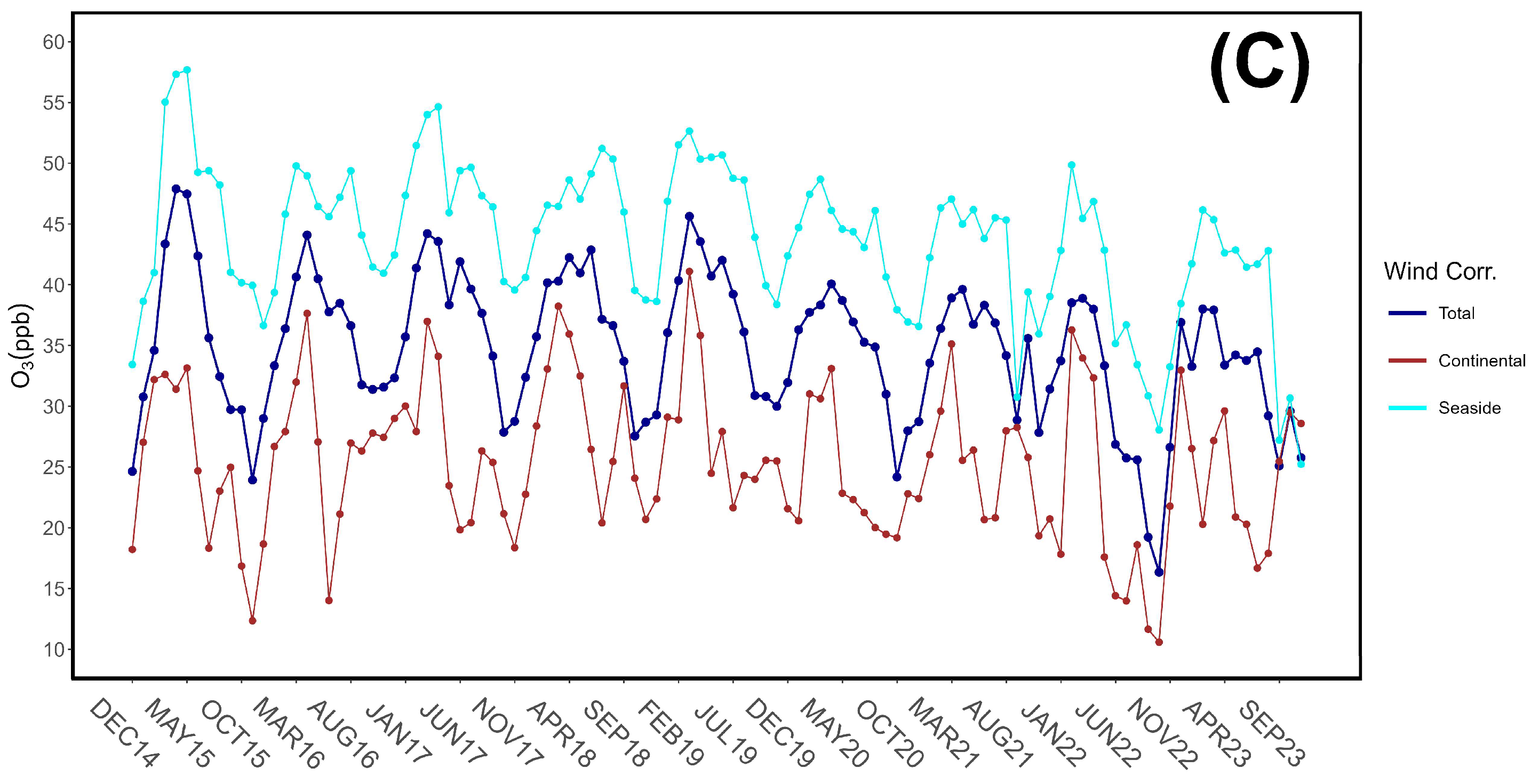
| Year | Hours | Ozone (%) | Meteo (%) | Combined (%) |
|---|---|---|---|---|
| 2015 | 8760 | 92.13 | 95.9 | 90.50 |
| 2016 | 8784 | 96.16 | 96.34 | 93.85 |
| 2017 | 8760 | 95.92 | 93.8 | 91.30 |
| 2018 | 8760 | 98.12 | 77.05 | 75.73 |
| 2019 | 8760 | 94.2 | 98.59 | 94.16 |
| 2020 | 8784 | 98.5 | 99.98 | 98.48 |
| 2021 | 8760 | 91.15 | 99.74 | 90.98 |
| 2022 | 8760 | 85.22 | 90.11 | 81.98 |
| 2023 | 8760 | 81.95 | 96.3 | 80.55 |
| Total | 788881 | 92.592 | 94.22 | 88.612 |
Disclaimer/Publisher’s Note: The statements, opinions and data contained in all publications are solely those of the individual author(s) and contributor(s) and not of MDPI and/or the editor(s). MDPI and/or the editor(s) disclaim responsibility for any injury to people or property resulting from any ideas, methods, instructions or products referred to in the content. |
© 2024 by the authors. Licensee MDPI, Basel, Switzerland. This article is an open access article distributed under the terms and conditions of the Creative Commons Attribution (CC BY) license (http://creativecommons.org/licenses/by/4.0/).





